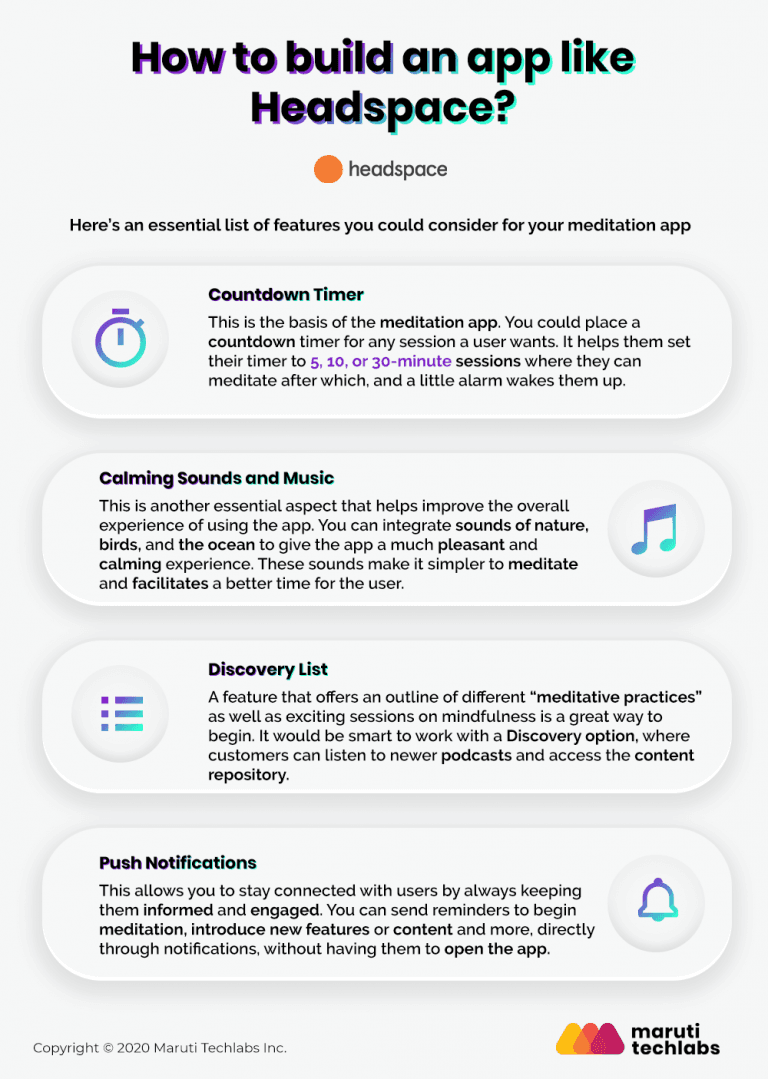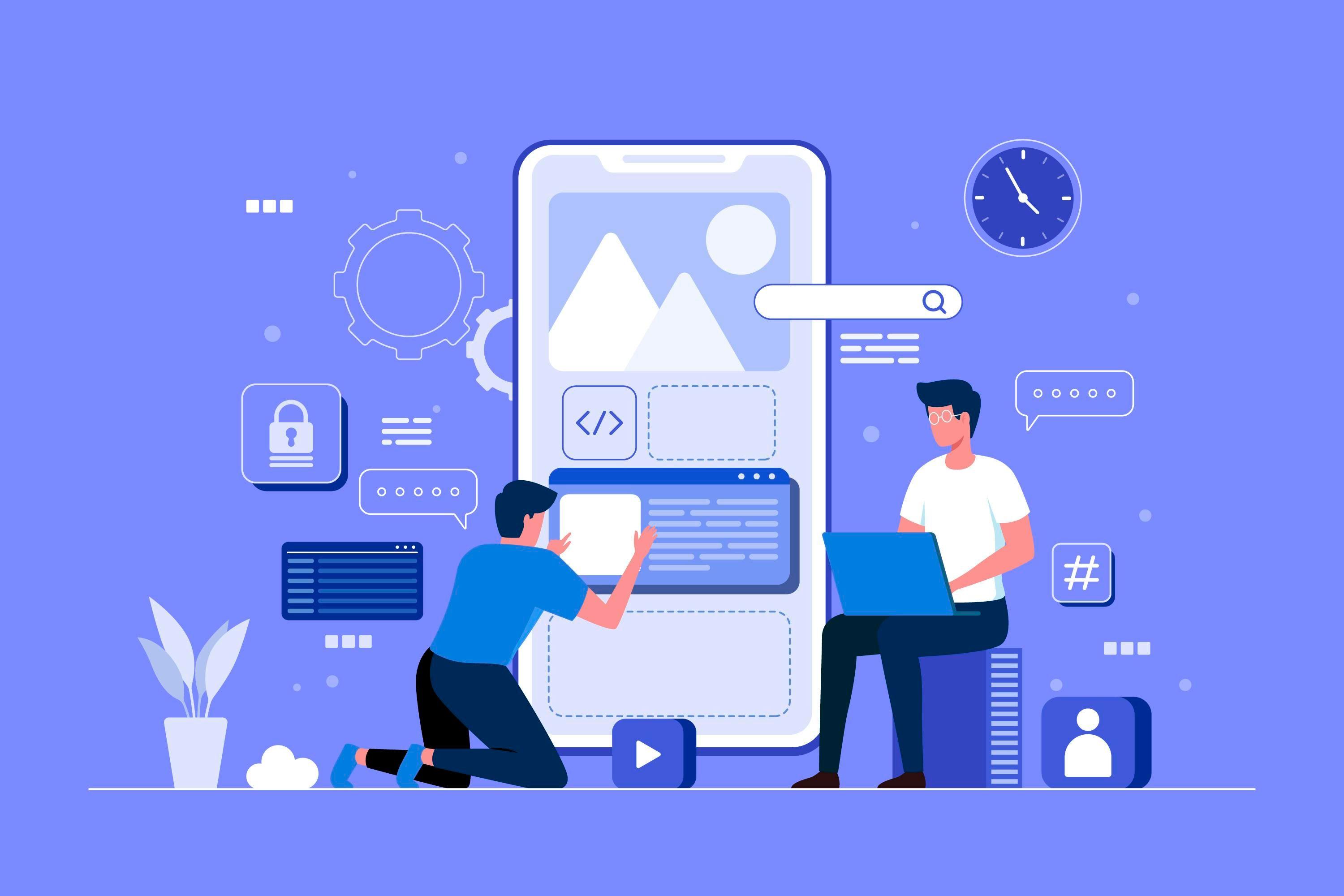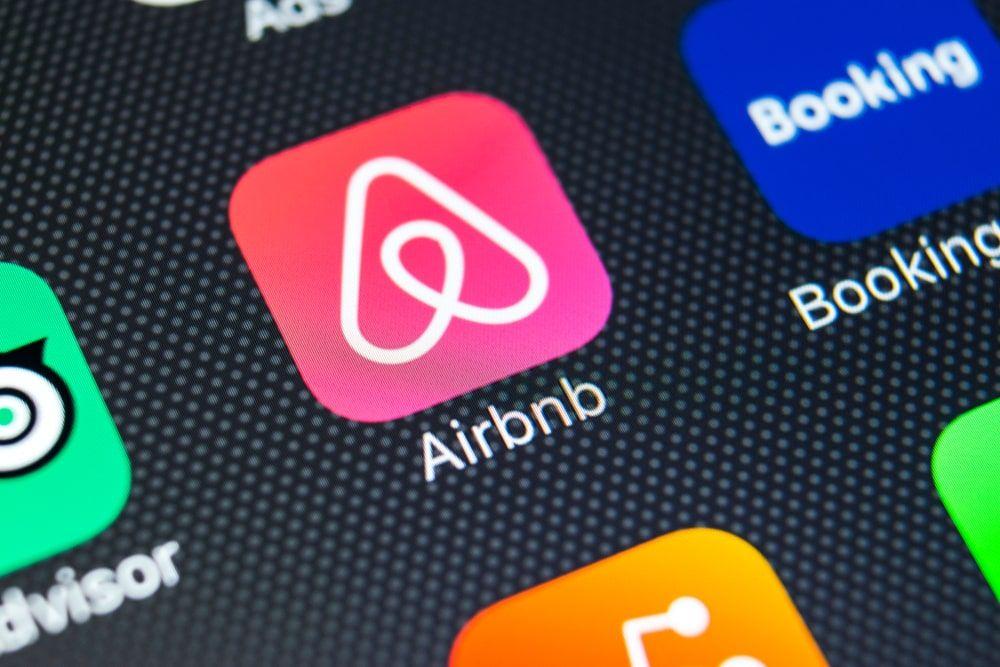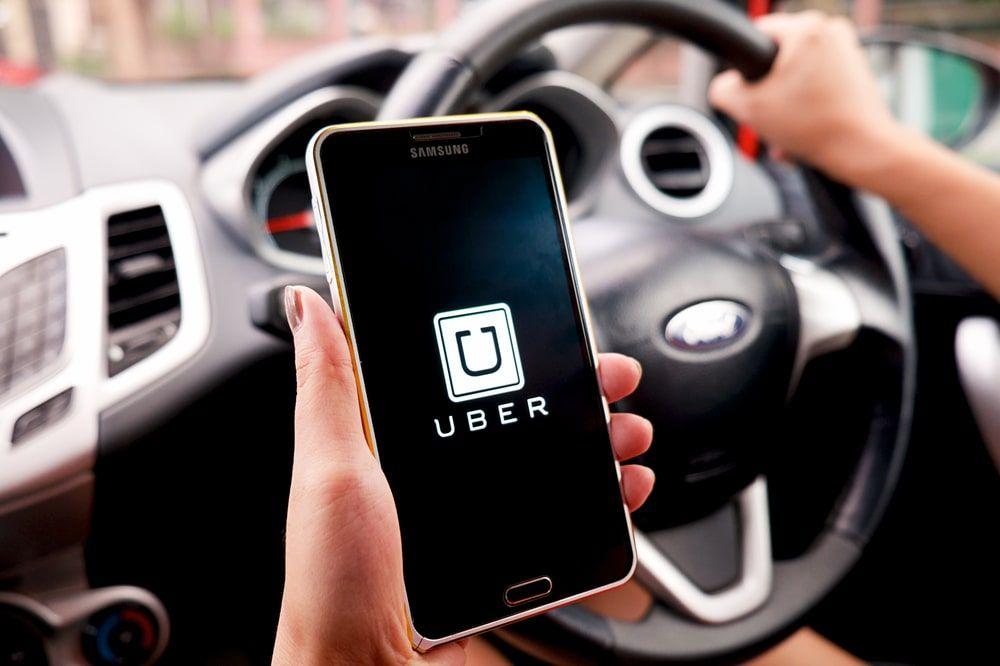How to Build a Meditation App Like Headspace?
Today, our lives have become hectic and dependent on digital gadgets. We’re continually available on phones and email, which means most of us to end up taking our work home with us. This can lead to stress, lack of sleep, and even insomnia in many cases and a general lack of attention to mental health.
When life gets fast and too much to handle, it’s important to remember why we created technology – to make it easier. To get into a zen-like mental state, you need to peel away from your stress and meditate to ward off chaotic thoughts.
Thankfully, you can now work with a mobile as well to get yourself to a mindful state with the help of calming apps. While it’s not possible to head out into green pastures and sit under a banyan tree, you can still make use of technology to give you a similar experience of serenity and mindfulness.
An app like Headspace or Oak allows you to listen to calm music, podcast discussions, and more. If you're planning on building a meditation app, ensuring it is successful is important. For this, working with a product management consulting firm with expertise in this area is essential.
At Maruti Techlabs, we specialize in helping businesses develop innovative products that meet the needs of modern consumers. With our extensive experience in product consulting, we can guide you through every stage of the app development process, from ideation to launch.

Why are meditation apps like Headspace popular?
Apps such as Headspace allow us to marry our love for technology with our passion for mental peace. As of today, WHO estimates that 1 in 4 people suffer from some sort of mental illness, and this is expected to grow. An app like Headspace can play a significant role in calming people down, and this is why they’ve been able to taste success. Positioned as a “monk in your pocket,” Headspace was founded by a Buddhist monk. Well, sort of.
Andy Puddicombe from the UK, traveled to India to study Buddhism as he felt unhappy inside about his life’s purpose. After spending a decade with the monks, he returned and created Headspace with the idea of allowing people to enjoy better mental health, with a little help from their smartphones.
Everything about the app exudes calmness from the smooth transition to the colors to the push notifications. With the idea to help the restless millennial and Gen-Z generations find some semblance of inner peace, Headspace has been successful in convincing people to take a few minutes every day or week for the benefit of their mental health.
Headspace has also led to the creation of other similar apps like Oak and Calm, and they, too, have features that promote mental health and happiness, among others.
You, too, can transform your unique idea into a feature-rich app like Headspace or Oak by hiring dedicated mobile app developers from a reputed software development company like ours. We not only help you develop the app, but our expert product management team walks with you at every stage, from testing the feasibility and profitability of your idea to ensuring market penetration.
How to build an app like Headspace?
To be able to build an app on the scale of Headspace, it will require a lot of time and resources, but you can start with the basics for now.
One of the primary requirements with this is an app development framework. And one of the most secure and prevailing frameworks you can opt for is ASP.NET.
As there are many verticles to cover when creating an app like Headspace, either you can't do it all by yourself or you might not have the required proficiency with this language. To meet these requisites above, you can always seek expert guidance from Dot Net full-stack developers, who'd handle user and server-side implementation from inception to deployment.
What are some must-have features you can make use of? That’s the first and most important question you’ve to put forth before you head forward and create it. Here’s an essential list of features you could consider –

- Countdown Timer – This is the basis of the meditation app. You could place a countdown timer for any session a user wants. It helps them set their timer to 5, 10, or 30-minute sessions where they can meditate after which, and a little alarm wakes them up.
- Calming Sounds and Music – This is another essential aspect that helps improve the overall experience of using the app. You can integrate sounds of nature, birds, and the ocean to give the app a much pleasant and calming experience. These sounds make it simpler to meditate and facilitates a better time for the user.
- Discovery List – A feature that offers an outline of different “meditative practices” as well as exciting sessions on mindfulness is a great way to begin. It would be smart to work with a Discovery option, where customers can listen to newer podcasts and access the content repository.
- Push Notifications – This allows you to stay connected with users by always keeping them informed and engaged. You can send reminders to begin meditation, introduce new features or content, and more, directly through notifications, without having them to open the app.
User Experience –
From a UX perspective – transition effects, colors, and overall look and feel need to calm the viewer’s mind. Colors can go a long way in achieving this, with pastel colors the best bet in such scenarios. Light greens, blues, and pinks can calm the mind, and we’ve explored the design elements further down in this article.
To ensure a successful web or mobile application with a positive user experience, consider leveraging React.js, an open-source JavaScript-based UI library. UI/UX developers favor React for its features like dynamic app development, reusable components, and scalability.
Connect with a React.js web development company to explore further benefits of this framework. It would streamline the app development process and boost your confidence during deployment.
Overall, UX must focus on gamification and encouragement. The app must be easy to navigate, and as you add more features, you must have a short introductory video as well. For now, the most basic UX features can include quotes during the transition, more comfortable navigating options, illustrations that bring a smile to the user’s face, and some soothing sound-effects/music.
Steps to Develop a Headspace App Clone
Here are the steps to create a successful meditation app like Headspace.
Step 1: Finalize your Business Idea
Deciding on the concept of your app idea is essential before you connect with a mobile app development company. Meditation apps are designed to offer specific services. Here is a summary of the types of meditation apps currently available.
- Guided Meditation Apps
Guided meditation apps provide diverse sessions led by experienced guides, catering to user preferences like sleep, stress, and SOS meditations.
One example of this type of app is Headspace. It introduces a first-time user with 10-minute sessions categorized as level 1. After concluding the same, a user can move forward to the next level and access the entire library with a paid subscription.
- Mindfulness and Stress Reduction Apps
They focus on reducing stress by promoting mindfulness in everyday activities. These apps often include deep breathing exercises, relaxation techniques, and stress monitoring.
A well-known meditation app of this type, Calm, features celebrity-led meditation, soothing sounds, ambient music, and sleep stories. It provides meditation reminders and mood tracking. Additionally, Calm users can join their social communities on Instagram, Facebook, and Twitter.
- Community and Social Meditation Apps
Apps in this category emphasize building a community of like-minded individuals who meditate together and share their experiences. They offer geolocation-based group connections.
Insight Timer, a mindfulness app, includes these features and boasts an extensive podcast library featuring experts in neuroscience and psychology from prestigious institutions like Stanford, Harvard, and Oxford.
Step 2: Creating an Appealing UI/UX
Your meditation app should align with your objectives. A user-friendly UI/UX greatly influences adoption and retention because it focuses on sensitive topics like anxiety and stress.
Users facing these problems can become upset if your app has confusing navigation, color choices, or other design issues.
Here are a few tips to consider when designing an app like Headspace.
- Opt for soothing pastel colors like millennial pink, whimsical yellow, and lavender.
- Aim for a calming initial user experience, avoiding too many design elements.
- Prioritize animations over text to explain meditation techniques, complex topics, and storytelling in a fairy-tale style.
Step 3: Choosing the Right Mobile App Platform
Firstly, you should examine the demographic profiles of your Android and iOS users. Depending on this, you can finalize if you wish to make Android and iOS apps. Other factors such as preferences, location, income level, education, and more are essential considerations when choosing your mobile app platform.
The selection of a mobile app platform hinges on your budget. Furthermore, deciding on native or cross-platform technologies will directly impact your meditation app development cost, with native apps incurring higher costs than hybrid alternatives.
Step 4: Introduce Gamification to Increase User Engagement
Implementing the perfect marketing strategy with an active social media campaign can initially secure the first 1000 downloads for your app. However, the real challenge lies in converting those initial users into daily active users and inspiring them to adopt a subscription plan, making revenue generation for your app's sustainability easier.
To achieve this, you must add gamification to your app. For instance, you can keep a point score or a badge for users who complete meditation sessions.
Everyone is competitive at some level. Some like to compete with others, while others will return to keep a personal streak going. The unbeatable urge to maintain a high score will improve your KPIs and increase paid subscriptions. You can try an A/B test on your users to know which gamification model they are more likely to engage with.
Step 5: Create an MVP
Before you develop a mobile app for your meditation app, validating your idea is essential. As app development can prove to be a costly affair, it's suggested that you first opt to build a Minimal Viable Product (MVP).
This approach not only helps you save resources but also helps you analyze and know user behavior and preferences. Your learnings can guide you in adding high-demand features in the subsequent development phases.
We recommend not including intricate features like video streaming, in-app payments, and chat modules. Instead, your meditation app can consist of features such as:
- User sign-up / sign-in
- Customer profiles with progress monitoring
- Short introductory meditation and mindfulness courses
- Limited pre-recorded sessions
- Gamification elements to promote user engagement
Essentials of Meditation App Development
Before commencing your mindfulness app development journey, ensure clear plans for further app monetization, scaling, and adding advanced features.
Here are two essential components to consider before you create your meditation app.
1. Architecture
To avoid scalability issues with your app, employ cloud solutions such as Google or Amazon Web Services for backend management. It enhances scalability by broadening data processing, sharing capacities, and storing extensive files, offering benefits like:
- Decreased device data storage
- Data synchronization across various devices
- Facilitate delivery of messages and notifications
- Reduce power consumption to prolong battery life
2. Live Streaming
The meditation app market is reaching its saturation. Thus, your app would need an X-factor to stand out, and video streaming can be a USP for your app.
To your benefit, you can equip your app with a broadcast-quality stream for your iOS and Android apps by leveraging:
- Cloud CDN, cloud storage, and Google compute engine for infrastructures
- High-performance live streaming using Anvato SDK
- Using these resources, you can also integrate live streaming into your existing mobile app.
What are some top features of meditation apps like Headspace?
To successfully build an app such as Headspace, you’ll need to craft a user experience that will slowly introduce the customer to the product before you talk about other features.
- Onboarding –
Introducing the app is a crucial aspect if you’d like them to stay on-board and interact over the long term. As meditation grows in popularity, more people would download the app, and the first impression must be positive. You can follow the steps mentioned while creating a short, 1-2 minute onboarding video:
- Don’t talk about all of the features in one go. The onboarding process must highlight features that you feel are important, and users can discover the rest on their own.
- Just introduce the app, what it does, and how they can navigate its many parts.
- If you’re planning to mimic Headspace, you can use a similar one-minute animated video option to introduce the features to the general audience.
- Design Elements
- Colour
From a design perspective, as mentioned before, you can use calming pastel colors. Bright colors trigger excitement and other moods in the brain, and that’s why you must opt for options like green, blue, brown, or purple. Most of them are earthy colors, and you can take a leaf out of Headspace’s app for this.
- Illustrations
Apps like Headspace and Calm make use of the pink and purple well, and you need to ensure that the design isn’t too cluttered. Keep it minimal, introduce cute or funny illustrations, and you’re set.
- Animations
If you’re planning on having video elements in your app, you must ensure they are dull and smooth. Users must be impressed with the style of animations you’re using, and they need to be used functionally rather than just to fill the gaps. You can have calming fade-in effects with the sounds of nature, for example, if you’re planning on displaying quotes.
To create a specific mood, try to tap into designers who are known for their minimalistic, simple illustrations because, in this case, less is more.
You will be able to catch a proper wave and also help users enjoy an after-effect from the meditation sessions with the help of the right animations.
- Personalization
In today’s data-driven world, personalization is vital. It is essential if you’re creating an app like Headspace that you personalize it for the user to enjoy –
- Tailor their Experience –
While people come to the app for different reasons, it’s essential that they can see some value in it. By tailoring their experience based on their activity – whether they spend five minutes to an hour a day, you’ll be able to provide them with some personalized features. Figure out what they enjoy when they’re on the app, and you’ll be able to retain as well as engage them over the long term.
It would be best to have an intelligent framework to create tailor-made web and mobile applications, and Angular.js is a leading one.
Its prominent features include MVC architecture, compatibility, and dependency injection. Being coined as the best Angular.js development company in the market, we have enough experience to vouch for this framework's robustness and scalability.
- Gamification –
Everybody loves a reward system, and it’s a great way to keep things interesting. You can help users traverse a path of self-realization by giving them points and badges for their performances. Incentivizing their visits means they keep returning, and Headspace does this well by allowing users to track their daily performance on the app. This can also help you create a loyalty program and, thus, smartly weave these users into a paid subscription as well.
- Familiar Sights and Sounds –
Using calming sounds like the ocean, breeze, jungle sounds to personalize the experience for the user. Depending on what seems they prefer, you can offer them with packages they can use while meditating. This can also be extended to visual effects, with nature-inspired imagery and pictures used to enhance the whole meditating experience for the user.
Familiar sights and sounds give the user a more enjoyable experience, and they’ll look forward to visiting the app on a more regular basis. You can also use voice actors who have soothing voices to read out some of the material or content or have podcasts narrated by life coaches and other purveyors of serenity – like monks.
- Discovery Option –
As a user discovers the app and arrives regularly, you need to have a section where you’re beta-testing or even introducing newer features. This will give them more reasons to fall in love with the app, and you can provide them with access to these features on the side. Free trials or discounted subscriptions are two of the options you can consider as rewards for users to discover more about the app.
- Push Notifications –
Even when they’re not on the app, you need to keep them engaged and interested. You can have reminders every day before their scheduled session to prep them before they enter. You could also push them for a 5 to the 10-minute session to take their minds off work.
Notifications about new packs and subscription reminders can be done via push notifications. Discounts and giveaways can also encourage users to keep coming back. Also, motivational quotes and congratulatory notes about their progress are other ways to use push notifications well. Make sure that these notifications are in line with the overall design aesthetic discussed earlier!
- Time –
You need to factor in the time it takes to create the app as well. From onboarding or recording the sounds, to actually coding all of the integrations, it will take time to get off the ground. Typically, an app like Headspace with all its functionality would take a few months, but a simpler version could take around 3 to 6 months to build, so factor that when you begin.
However, building a meditation app like Headspace becomes easier when you have the support and expertise of a software product development company like ours.
So, now you know the top features that you will need while developing an app like Headspace. We’re now going to dive into what will be the cost and timeline of building a meditation app.
Challenges in Creating a Headspace-like App
Building an app like Headspace is a challenging feat. Whether it’s creating a seamless user experience or increasing your subscription rate, there are several challenges that you have to overcome to launch a successful meditation app. Here are some prominent challenges to keep an eye out for.
1. Ensuring Ease of Use and Loading Speed
Myriad features constitute a meditation app. The foremost challenge app developers face is ensuring they are easy to navigate and have a quick loading speed.
2. App Localization
App localization involves tailoring the content to suit the linguistic, cultural, and regional preferences of a targeted location or audience. This tedious task involves upgrading to different date and time formats, translating texts and images, and accommodating other elements to offer a more personalized experience to its users. Mitigating these challenges while delivering the app on an estimated timeline would be crucial for your app development team.
3. Earning User Trust
Customers use an app trusting that it will offer them the solution, service, or product they need. Observing the current competition in the market, poor service, or a poor app experience can lead to losing customers.
Hence, it has become a challenge for businesses to sustain users while prompting them to pay for your services. Therefore, it's essential to instill an appropriate level of transparency in your app's operations.
4. Costly Subscriptions
We all like free services, especially the ones that offer health benefits. Most users exploring mindfulness apps are opposed to paying a subscription fee. But, getting enough subscriptions will make generating revenue easier for the app. Hence, it remains a paradox that requires a sensible approach.
Time and Cost to Build a Meditation App
Based on all the features listed above, our development team prepared a rough estimate of the time to develop. The idea here is to have a general ballpark of the potential cost to build a meditation app:

Now that we’ve covered how much developing a meditation app is going to cost you let’s dive into the next most crucial aspect.
How to Earn Money with your Meditation App?
Parts of this article already covered different scenarios and ideas on how you could potentially make money with an app like this. However, we decided to flesh it out a little bit more and list down all the possible options –

- Pay Per Download
While this method is frankly quite outdated and may act as a point of friction for potential users, a lot of apps still tend to use this monetization model.
- Subscription
Arguably, this happens to be tried, tested, and one of the most successful monetization models. The idea is to give your users complete access to all features, as long as they pay for them on a monthly or yearly basis. This model is best for companies looking to maintain a steady cash-flow and profitability. E.g., Headspace subscription charges are $12.99/month and $94.99/year, while their competitor Calm and Welzen charge $59.99/year.
- In-App Purchases
By implementing in-app purchases, you give your users unfiltered access to specific gated content. This can be moderately priced at $3 to $4 per purchase on top of your subscription model.
- Ads
Ads happen to be the cash-cow for almost every successful app out there. This monetization model allows you to leave your app free on the marketplace, which in turn acts as a catalyst towards user acquisition.
Do you also want to earn money with your meditation app? SaaS development services can help you bring your app idea to life and create a user-friendly experience that promotes mindfulness and relaxation.
Tips and Practices for Successful Meditation App Development like Headspace
Here are a few tips and practices to adhere to when developing an app like Calm or Headspace.
1. Search Bar
No matter how well you categorize your app's content, it's always a boon to have a search bar that delivers exact results for whatever a user wants. So, make sure you include one in your application.
2. Introduce Tech like AR/VR
Using techs such as AR/VR, you can better enhance the meditation experience by addressing an individual’s fears and anxieties. It can expedite the process of improving their mental health. To implement this effectively, you should brainstorm ideas with your hired development team before you proceed with app development.
3. Create an MVP
The budget you have for app development doesn't necessarily determine the success or effectiveness of your MVP. Its primary aim is to validate whether your app idea is worth investing in.
With an MVP, you will need minimal resources and time to enter the market. Moreover, learning the user response, likes, dislikes, and other preferences and feedback can help create a feature-loaded app with an utterly user-centric experience.
Tips from the Development Team
Based on our experience over the last decade on building apps for Android and iOS, our development team compiled a series of tools that could be useful for all aspects of your project.
- Push Notifications – Firebase SDK
- Payment Processing – Stripe
- SignUp/Customer Analytics/Support – Facebook Mobile SDKs
Conclusion
Staying mindful and enjoying life is the best way to live, and building an app to help you do so is a great idea. Work with the tools you have and continuously improvise – you’ll eventually get there!
While primarily delivering services through mobile applications, establishing a web presence for a mindfulness application remains a valuable strategy. A website is a central hub for information, user engagement, and promotional activities. If you're contemplating the development of a progressive web application (PWA), collaborating with Python programmers is an intelligent decision.
Make sure you calculate everything required to create such an app well beforehand because it will help you understand your limitations and budget over the long term. From a development perspective, it is not very complicated or expensive and has proved to be one of the most profitable ventures for a lot of companies. Statista reports that the market for the meditation space is estimated to be around $ 1.21 billion, and it is predicted to be worth $2 billion by 2022.
Enjoy building it, including some unique features, and you’ll be well on your way to getting plenty of interested customers on-board. Get in touch with us for the rapid prototyping of your app development idea. We are well equipped to help you with your app development needs, and share an estimation in terms of costs and timelines within 24 hours.
Write to us at hello@marutitech.com with your idea, and let’s build something together.






















